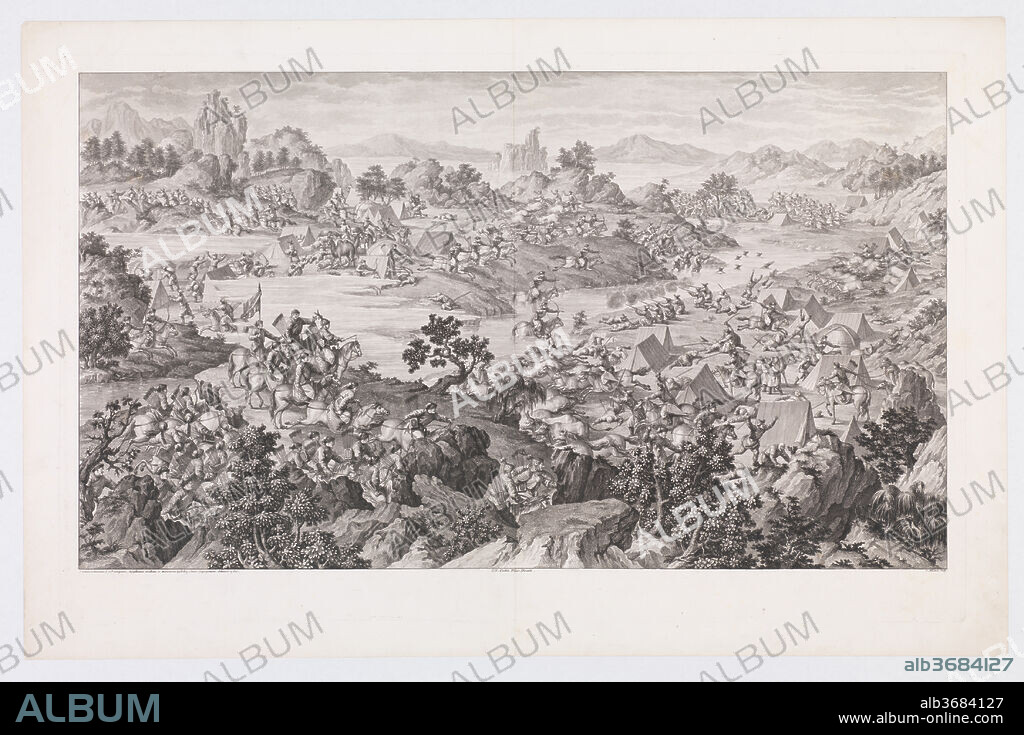alb3684127
JACQUES ALIAMET, (DIREXIT) CHARLES NICOLAS COCHIN II, AFTER GIOVANNI DAMASCENO SALUSTI. The Combat of Khurungui

|
Add to another lightbox |
|
Add to another lightbox |



Author:
Title:
The Combat of Khurungui
Caption:
The Combat of Khurungui. Artist: (direxit) Charles Nicolas Cochin II (French, Paris 1715-1790 Paris); after Giovanni Damasceno Salusti (1727-1781); Jacques Aliamet (French, Abbeville 1726-1788 Paris). Dimensions: Sheet: 39 11/16 × 25 11/16 in. (100.8 × 65.3 cm)
Plate: 22 15/16 × 36 9/16 in. (58.2 × 92.8 cm). Series/Portfolio: The Conquests of the Emperor of China
(Les Conquêtes de l'Empereur de la Chine). Date: 1774.
This print depicts the 1758 Combat of Khurungui, showing Chinese troops led by Zhaohui and his lieutenants attacking Amursana's supporters who, after their defeat at Khorgos, went to Mount Khurungui, located north of the river Ili.
Part of a set of sixteen, "The Combat of Khurungui" was commissioned by the Qianlong Emperor in 1765 to commemorate Manchu victories (1755-59) over the Eleuths, the Dzungars, and other Central Asian peoples in the present-day region of Xinjiang. Made under the direction of Charles-Nicolas Cochin (1715-1790), the prints, which follow reduced-scale copies of paintings by Jesuit artists working in Beijing, were etched and engraved in France from 1767 to 1774 by the finest printmakers at the court of Louis XV. The Chinese merchants of Canton (present-day Guangzhou) paid for the copper plates and two hundred sets of prints to be delivered to China, with only a few sets retained in Paris.
The prints exemplify the fusion of Eastern and Western representational styles fostered within the Qing imperial painting academy. The European technique of chiaroscuro-the modeling of forms through the use of light and shading-has been visibly tempered, as has the use of one-point perspective. Instead, the scenes present panoramic views and strongly up-tilt ground planes. At the same time, howevery, they reflect European preferences for anatomical accuracy, a single light source, and the mathematically correct reduction of scale to create the illusion of recession.
Technique/material:
etching and engraving
Museum:
Metropolitan Museum of Art, New York, USA
Credit:
Album / Metropolitan Museum of Art, NY
Releases:
Model: No - Property: No
Rights questions?
Rights questions?
Image size:
4400 x 2930 px | 36.9 MB
Print size:
37.3 x 24.8 cm | 14.7 x 9.8 in (300 dpi)
 Pinterest
Pinterest Twitter
Twitter Facebook
Facebook Copy link
Copy link Email
Email
